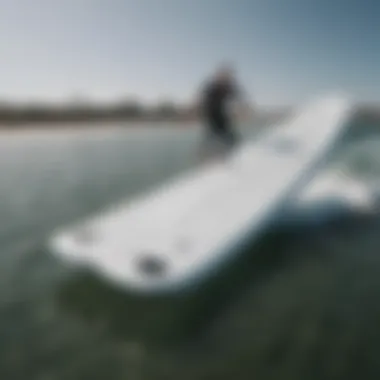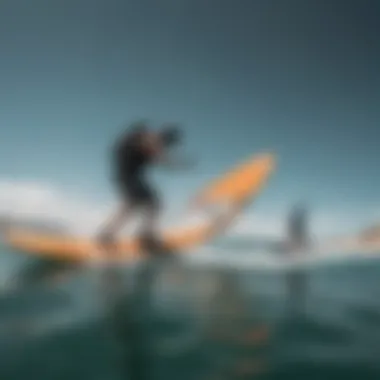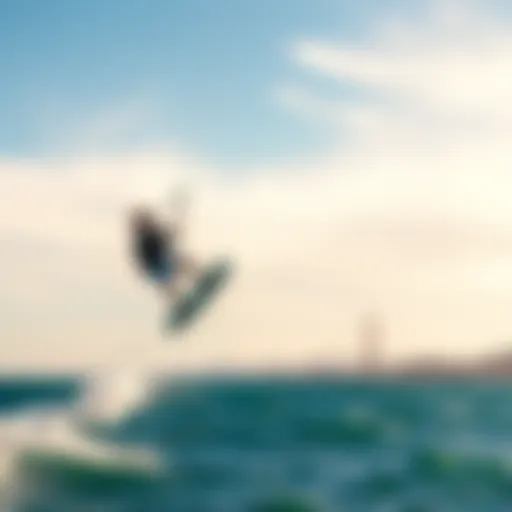Inflatable Wingboard: A Complete Guide for Kiteboarders


Intro
The world of kiteboarding is constantly evolving, with new innovations allowing riders to explore the waters like never before. One such innovation making waves in the scene is the inflatable wingboard. It’s a fascinating combination of design ingenuity and practical performance, tailor-made for both seasoned kiteboarders and those just starting their journey.
What sets inflatable wingboards apart? The answer lies in their versatile construction, ease of transportation, and ability to adapt to various water conditions. In this exploration, we aim to unpack what makes the inflatable wingboard an essential piece of gear, along with its benefits and potential drawbacks.
Let’s dive deep into the Gear Insights needed to elevate your kiteboarding experience.
Gear Insights
Latest Gear Reviews
Choosing the right equipment is pivotal. Inflatable wingboards come in various shapes and sizes, each crafted for specific conditions and rider preferences. Recent reviews show a growing appreciation for brands like Slingshot and Naish, both recognized for their quality build and performance.
For instance, the Slingshot Fury is praised for its balance and maneuverability, making it a great choice for intermediate riders aiming to push their limits. Meanwhile, the Naish Wingsurfer has been lauded for its compact design and overall stability, appealing to beginners who desire a straightforward learning curve.
When evaluating these boards, consider the following factors:
- Weight Capacity: Ensures the board can handle your specific requirements without compromising on performance.
- Material Durability: High-quality materials enhance longevity and resistance to wear.
- Inflation Method: Quick inflation systems can save precious time at the water’s edge.
Essential Gear for Beginners
If you’re new to kiteboarding, picking out an inflatable wingboard might feel overwhelming. To ease the process, here’s a checklist of essential gear that pairs well with your board:
- Recreational Kite: Choose a lightweight kite that is easy to control.
- Personal Flotation Device: Safety should never take a back seat. A good life jacket or vest will ensure you’re protected.
- Harness: A comfortable harness allows you to enjoy longer sessions without draining your energy.
- Leash: This keeps the board close in case of a wipeout, preventing it from drifting away.
For those embarking on their kiteboarding journey, it’s crucial to invest in quality gear that facilitates learning. The right combination ensures you’re set up for success right from the start.
Techniques and Tips
Advanced Tricks and Techniques
As you grow more comfortable on the inflatable wingboard, mastering advanced techniques can be exhilarating. Tricks like the v180 or downwind surf showcase the skill involved in kiteboarding, blending agility with creativity. Practice in safe, controlled environments before attempting them in open waters.
Safety Practices for Kiteboarders
While the thrill of kiteboarding is undeniable, safety cannot be overlooked. Consider these best practices:
- Always check the weather conditions before heading out – avoid stormy or overly windy days.
- Make sure your gear is well-maintained. Regularly inspect your board and kite for signs of wear.
- Join a kiteboarding community to share tips and strategies, benefiting from the experience of fellow enthusiasts.
“Preparation is the key to a successful session. Take your time to understand the equipment and conditions.”
End
With an inflatable wingboard, the opportunities for exploration and fun are endless. By understanding the gear, techniques, and safety practices involved, you will be better equipped to enjoy this thrilling sport. The more you learn, the more vibrant your kiteboarding experience will be.
Prologue to Inflatable Wingboards
Inflatable wingboards have become a noteworthy part of the kiteboarding community, reshaping how both new and seasoned riders approach the sport. These boards are particularly appealing due to their unique design and versatility. Understanding inflatable wingboards is crucial not just for enthusiasts but also for those who teach the art of kiteboarding, as these tools can significantly enhance the riding experience.
Definition and Evolution
Inflatable wingboards, simply put, are boards that use air-filled compartments to provide support and buoyancy. Unlike traditional hard boards, which can be cumbersome to transport and store, inflatable variants can be deflated and packed away, making them exceptionally travel-friendly. This adaptability has led to their rise in popularity, especially among adventurous spirits eager to hit the water wherever the wind might take them.
The evolution of inflatable wingboards stems from advancements in technology and materials. Early models were often criticized for their lack of stability or performance. However, recent innovations have addressed these issues, allowing for a comfortable ride even under challenging conditions. Manufacturers have experimented with various shapes, sizes, and designs to create boards that not only ride well but also cater to a wide range of skill levels.
Market Trends
The rise of inflatable wingboards reflects broader trends in the water sports market. These boards are increasingly favored due to their practical benefits. For instance, the importance of portability cannot be understated. Many kiteboarders are travelers at heart, and the ability to easily pack a board into luggage is a game changer.
Moreover, eco-conscious buying is influencing the market too. Companies are leaning towards sustainable materials, responding to a growing demand for green products in all sectors, including sports equipment. This shift not only appeals to environmentally-aware consumers but also fosters a more sustainable kiteboarding culture.
Engagement in community events has also been a factor in the boards' popularity—groups often host competitions or meetups centered around these inflatable designs, encouraging camaraderie and competition. As more people discover inflatable wingboards, they add to a culture that appreciates innovation, adventure, and shared experience.
"Inflatable wingboards are not just a passing fad; they're a reflection of the way we interact with our environment while participating in sports."
Design Principles of Inflatable Wingboards
When diving into the world of inflatable wingboards, understanding the design principles is crucial. These principles encompass the materials used, construction techniques, and ergonomic features that ultimately dictate the performance and user experience of the board. Each element intertwines, forming a cohesive unit that meets the varied needs of kiteboarders. Let's break it down.
Materials Used
The foundation of any inflatable wingboard lies primarily in the materials from which it's made. Notably, a majority of boards utilize high-denier polyester or nylon fabric, which provides an excellent balance of strength and flexibility. These materials are often coated with PVC or TPU to enhance water resistance and durability. By employing such materials, manufacturers ensure that the boards can withstand the rigors of saltwater, UV exposure, and everyday wear and tear. This is particularly vital when one considers the challenges posed by varying environmental conditions.
- Durability: Boards made from double-layered or reinforced materials offer better resilience against accidental punctures.
- Weight: Lighter materials lead to increased performance, enabling faster speeds on the water.
- Flexibility: The allowance for bending and flexing enhances control during maneuvers, thereby improving the overall ride experience.
Construction Techniques


Another vital aspect involves the techniques employed in the board's construction. There are various methods, but two of the most notable are hot air welding and thermo-sealing. Hot air welding is a method that employs heated air to bond the seams of the material together. This creates a strong, airtight seal that minimizes the risk of leaks. On the other hand, thermo-sealing uses heat and pressure to fuse materials, resulting in a more durable connection that can withstand the stresses of inflation and deflation.
Considerations in construction techniques also include design features such as multiple air chambers for added safety and stability. When one chamber is compromised, others still provide buoyancy, ensuring that the rider remains afloat. This can be a game-changer in emergency situations, as it enhances user safety without sacrificing performance.
"The interplay of materials and construction techniques can make or break your experience on the water—always look for quality craftsmanship."
Ergonomics and User Comfort
Finally, user comfort cannot be overlooked. Ergonomics plays a pivotal role in how a rider interacts with their wingboard. Thoughtful design can elevate the overall usage experience significantly. Inflatable wingboards often incorporate features such as padded footstraps and contoured deck surfaces. These aspects help distribute pressure evenly, which reduces fatigue during extended rides.
In addition, many models emphasize intuitive control layouts, allowing riders to make quick adjustments while in motion. This means that gazing out onto the water and adjusting your stance isn't a clumsy ordeal—it’s fluid, ensuring that the experience remains enjoyable.
- Adjustable Features: Footstraps and handles that can accommodate various foot sizes enhance versatility.
- Non-Slip Surfaces: Textured areas on the board offer better grip, which is vital during jumps and quick maneuvers.
Advantages of Inflatable Wingboards
Inflatable wingboards are a game-changer in the kiteboarding realm, making them a top choice for many enthusiasts. They offer a blend of portability, durability, and adaptability that traditional boards simply cannot match. Understanding these advantages not only highlights their unique characteristics but also helps kiteboarders, whether seasoned or new, to appreciate why they have become increasingly popular. Let's break down the core benefits:
Portability and Storage
One of the most remarkable features of inflatable wingboards is their portability. Unlike rigid boards, inflatable versions can be deflated and rolled up into a compact size. This is a godsend for travelers, allowing them to easily stash their gear in the trunk of a car or even fit it in a suitcase for air travel. For adventurers who like to explore new locations, being able to pack light is crucial, especially when tackleing rugged terrains.
Think about your past trips; when was the last time you struggled to fit your board into the car? Inflatable wingboards eliminate that struggle, making kiteboarding accessible no matter where the road takes you.
Moreover, their lightweight nature means you won’t have to break your back lugging equipment around. Many wingboarders share stories about how they simply inflate their boards at the beach, ready for action in minutes. It’s almost like having your cake and eating it too, where convenience doesn’t come at the cost of performance.
Durability and Resilience
Durability is another key advantage of inflatable wingboards; they are specifically designed to withstand the rigors of various environments. The materials used in the construction process, such as drop-stitch fabric, create a stable and durable product that can handle scuffs and scrapes. No kiteboarder wants a board that’s going to suffer damage at the first bump against a rock or sand.
In fact, many riders have reported years of successful use with minimal signs of wear. And let’s be honest, kiteboarding can be a rough-and-tumble sport. From rocky waves to sandy beaches, these boards are built to endure.
Additionally, should a puncture or tear occur, repairing an inflatable board is often straightforward; patches are typically included with most kits. This means you can get back on the water without needing to invest heavily in repairs or replacements.
Performance in Varied Conditions
Performance is, of course, what every kiteboarder chases, and inflatable wingboards deliver on this front as well. One might think that a soft board would compromise stability or speed, but that’s not the case here. Inflatable boards actually offer impressive support underfoot. They don’t just float; they provide a solid platform for takeoffs and landings.
Whether you are riding in choppy waters or glassy conditions, the flexibility of inflatable boards helps absorb impacts and allows for smooth rides. In strong winds, these wings also seem to have an innate ability to slice through the waves, maintaining speed without undue effort.
"Inflatable wingboards offer unparalleled performance stability across a range of environmental conditions, making them perfect for both newcomers and advanced kiteboarders."
In summary, the advantages of inflatable wingboards stem from their thoughtful design that caters to a variety of needs. Their portability makes them a fantastic choice for on-the-go water lovers, and their durability means they are built to last. Performance in diverse settings further solidifies their place in the kiteboarding community. If you are ready to elevate your kiteboarding experience, consider embracing the innovations in inflatable wingboards.
Performance Metrics and Features
Understanding the performance metrics and features of inflatable wingboards is fundamental to optimizing your kiteboarding experience. The unique characteristics of these boards can significantly affect an individual’s ability to ride effectively across varying water conditions. As kiteboarding continues to gain popularity, knowing what to look for can help select the right gear tailored to one’s skill set and style.
Speed and Maneuverability
When it comes to kiteboarding, speed is often the name of the game. Inflatable wingboards are designed with specific profiles that can enhance speed, making them suitable for a range of riders. One key aspect influencing speed is the shape of the board. A sleek profile generally allows for smoother glide over water. In tandem, the fins'' placement plays a pivotal role — closer fins can translate to quicker turns, while broader spacing could enhance straight-line speed, giving you options based on your riding preferences.
Moreover, maneuverability is what separates good riders from great ones. An inflatable wingboard that's too rigid may offer speed but at the cost of control. Conversely, an overly flexible board may provide a cushy ride but could lag in responsiveness. It's the fine balance between rigidity and flexibility that you should assess when selecting your board. Whether you're cutting through the waves or engaging in aerial tricks, a board that reacts well to your inputs directly elevates your overall ride experience.
Stability and Control
Stability is non-negotiable when it comes to kiteboarding, particularly for beginners. Inflatable wingboards often feature a wider base, which significantly enhances stability. This is especially crucial when navigating choppy waters or performing jumps. A stable board allows riders to focus less on balance, providing more room to refine their techniques and concentrate on their environment.
Control extends from stability. Some boards come equipped with adjustable foot straps, allowing you to dial in your fit for more confidence on the water. Additionally, deck pads with good grip provide essential feedback — when you know your feet are secure, you can push your limits with more ease. Riders should always inquire about the control system; understanding how a board reacts under various conditions can make or break a session. As with anything, situational awareness when it comes to control can pay dividends — no one ever goes home unhappy from a day of solid kiteboarding.
Ride Experience Analysis
Analyzing your ride experience thoroughly is the best way to ensure that your inflatable wingboard is suited to your style. Several elements come into play here, including comfort, responsiveness, and overall enjoyment. The angle of the rocker, or the curve the board takes from nose to tail, can dramatically alter your ride experience. A more pronounced rocker can help in wave riding but may sacrifice speed on flatter waters; conversely, a flatter rocker facilitates speed and easier planing but can make tackling waves a challenge.
In addition, the materials used in construction, such as drop-stitch technology or high-density PVC, influence not just performance but also feel on the water. The right choice of materials can lead to a plush experience with less feedback from the surface, making those chop-filled days a bit more manageable.
When selecting your board, consider testing various models. Take note of how each board responds during sharp turns or tuning into the wind — this information can provide clarity on what brings you the most joy.
Every rider’s preferences are unique, and the right inflatable wingboard can offer not just an engaging ride but a deeper connection to the sport itself.
In summary, speed, stability, control, and ride experience are all metrics that should weigh heavily in your selection of an inflatable wingboard. Taking the time to understand these dynamics will certainly enhance your time on the water, leading to progress in skills and overall enjoyment of kiteboarding.
Choosing the Right Inflatable Wingboard
Selecting the appropriate inflatable wingboard is crucial for enhancing your performance on the water, especially for those who are new to this thrilling activity or those who are looking to advance their skills. With a diverse range of models available in today’s market, understanding the essentials involves evaluating multiple factors including your skill level, the dimensions of the board, and recognizing reputable brands. By carefully considering these elements, you can ensure a more enjoyable experience.
Skill Level Considerations
Before diving headfirst into purchasing, take a moment to assess your current kiteboarding ability. Novices may want to seek out wider, longer boards as they tend to offer greater stability, which can be a lifesaver when you're just starting out. A wider board allows for more forgiveness when riding and is simpler to balance on.


Conversely, seasoned kiteboarders might look for something narrower or shorter. These models may maximize speed and responsiveness, giving experienced riders the maneuverbility necessary to perform tricks and dance on the waves. It’s vital to choose a board that matches your skill level to avoid frustrations and increase your overall enjoyment on the water.
"The right board can make all the difference between a thrilling ride and a struggle against the elements."
Size and Volume Guidance
The size and volume of an inflatable wingboard play a substantial role in its performance. Generally, a longer board will provide better tracking in the water, making it easier to navigate against wind and currents. Meanwhile, a wider board facilitates a stable platform, particularly for those who favor slower speeds or who may be carrying extra gear.
When considering volume, bear in mind:
- Higher Volume: The buoyancy offered by a board with more volume can support heavier riders or anyone looking to ride under varying conditions. It also helps maintain stability, crucial for novice riders.
- Lower Volume: On the flip side, lower volume models are advantageous for lighter riders or for those preferring a more nimble performance.
As a buyer, contemplating your weight, riding style, and preferences helps narrow down the suitable size and volume for your inflatable wingboard, promoting a smoother ride experience.
Brand Recommendations
Navigating through the landscape of inflatable wingboards can be daunting given the variety of brands out there. However, some manufacturers consistently emerge as trustworthy. Brands like Naish, Slingshot, and Cabrinha have garnered excellent reviews over the years.
- Naish: Renowned for their innovative designs and performance-driven boards, offering options across various skill levels.
- Slingshot: Popular among thrill-seekers, their boards are known for their durability and responsiveness in trick riding.
- Cabrinha: Their boards blend user-friendliness with versatility, making them favored choices for both newcomers and experts alike.
Before making any major investment, researching customer reviews and reaching out to community forums can provide valuable insight. Engaging with fellow kiteboarding enthusiasts on platforms like Reddit may yield personal experiences with specific models or brands, assisting in an informed decision.
Considering these factors while choosing the right inflatable wingboard not only ensures enhanced performance but also enriches your overall kiteboarding experience.
Maintenance and Care for Inflatable Wingboards
Maintaining an inflatable wingboard is like keeping a prized possession safe; it ensures that your gear remains in top-notch condition while also prolonging its lifespan. Proper maintenance and care can enhance performance, making your experience on the water smoother and more enjoyable. Here, we’ll cover essential cleaning techniques, storage tips, and procedures for inflation and deflation. Each aspect plays a pivotal role in ensuring your inflatable wingboard remains reliable through all the saltwater splashes and sunny days.
Proper Cleaning Techniques
After a day of kiteboarding, you might be tempted to just toss your inflatable wingboard in the garage and forget about it. But that would be like putting your shoes on without tying them—just not a good idea. Cleaning your board after each use is crucial to prevent salt and dirt from breaking down the material over time. Here are a few effective cleaning strategies:
- Freshwater Rinse: Always rinse your wingboard with fresh water after each session. This helps wash away salt, sand, and other debris that can degrade the material. A gentle stream is often sufficient; don’t blast it with high pressure as it may cause wear on seams and valves.
- Mild Soap Solution: Occasionally, you may find that a bit of soap is necessary. Mix a small amount of mild dish soap with water and use a soft sponge to wipe down the surfaces. This will help remove stubborn grime without damaging the board.
- Drying: After washing, let your board dry completely in a shaded area. Avoid direct sunlight, as prolonged exposure can cause the material to degrade.
To sum it up, a little attention to cleaning can go a long way in preserving your investment.
"Routine care can greatly reduce the wear and tear on your inflatable wingboard, making your adventures more enjoyable and worry-free."
Storage Tips for Longevity
When it comes to storage, think of your inflatable wingboard as a delicate flower—handle it with care. Proper storage can significantly extend the board's lifespan. Follow these guidelines to keep your gear safe:
- Cool, Dry Place: Store your wingboard in a cool, dry location. Avoid areas with extreme temperatures or humidity, as these conditions can warp or weaken the materials.
- Air it Out: Before folding and storing, ensure that the board is completely dry. You don’t want moisture trapped inside, as that could lead to mold or mildew.
- Avoid Sharp Objects: Keep your wingboard away from sharp objects or anything that may puncture its surface. If possible, use a protective bag or cover while storing it.
- Flat Storage: When storing your board, lay it flat rather than stacking heavy items on top. This prevents warping and maintains the board’s shape.
These steps might seem minor but can greatly benefit your wingboard’s health, keeping it ready for your next adventure.
Inflation and Deflation Procedures
Getting the inflation and deflation process right isn't just about convenience; it’s about safety and ease of use. Inflatable wingboards require a careful touch to ensure they’re in optimal condition. Here’s how to go about it:
- Inflation: Use a proper pump specifically designed for inflatable wingboards. Start by inserting the pump hose into the valve and making sure it's tightly secured. Begin pumping air slowly until you reach the recommended pressure indicated on the board. Avoid overinflation; too much pressure can compromise the seams and material.
- Deflation: To deflate, simply open the valve and allow the air to escape completely. Roll your board up from the tail to the nose to manage the folding process better. You want to make sure no air pockets remain, as they can lead to damage when the board is stored.
- Check Valves: After inflation and deflation, inspect the valves to ensure they’re secure and functioning properly. Any wear or damage here can lead to air leaks when you hit the water.
By following these inflation and deflation techniques, you’ll ensure your board remains in great shape and ready for action when the next kiteboarding adventure calls.
Inflatable Wingboard Accessories
The experience of using inflatable wingboards can be notably enhanced with the right accessories. These additional components not only improve performance but also add layers of safety and convenience that are vital for any enthusiastic kiteboarder. All kinds of accessories can transform an average session into something you'd want to relive.
Recommended Add-ons
Here are some key accessories that every inflatable wingboard enthusiast should consider:
- Foot Straps: These can make a world of difference in control and stability. By comfortably securing your feet to the board, you prevent accidental slips, which could lead to falls and injuries. You want that solid connection while you're chopping through waves, right?
- Leash: A leash essentially connects you to your board. If you lose grip on your board, a well-attached leash ensures it doesn’t float away. Trust me, chasing after a runaway board isn't much fun.
- Pump and Repair Kit: Pumps are non-negotiable for inflatable designs. Look for a high-quality double-action pump for faster inflation. A repair kit, on the other hand, safeguards against punctures or wear and tear that can happen during adventures.
- Carry Bag: Not many think about carry bags, but a good-quality one can make transporting your board a breeze. It offers protection from dirt and scratches, making it easier to store when not in use.
- Wetties: A good wetsuit keeps you cozy when the water's a bit brisk. Opt for one that suits the season to ensure comfort on your ventures.
Incorporating these accessories can elevate the experience of using inflatable wingboards, making every outing safer and more enjoyable.
Safety Equipment
Safety equipment is a must. The ocean can be unpredictable and having the right gear can be the difference between a good day and a bad one. Here’s what to consider for your next adventure:
- Personal Floatation Device (PFD): Always wear a certified PFD. It's not just a good idea; in many locations, it's the law. They keep you afloat in case of accidents and give you peace of mind to focus on riding.
- Helmet: It does not hurt to have some head protection. When riding in choppy waters or trying out new tricks, a helmet can prevent injuries from falls or unexpected collisions.
- Impact Vest: Similar to a helmet, an impact vest adds a level of safety, especially during heavy crashes. It provides both flotation and cushioning which is an essential when you’re just learning or pushing your limits in performance.
- Whistle: A simple accessory, but one that can be crucial. If you ever find yourself in trouble, especially when out in open waters, a signaling device can attract attention when you need help.
- Sunscreen and Protective Clothing: Though it might seem trivial, don’t underestimate sunburn while you’re out on the water for hours. A good waterproof sunscreen, along with UV protective clothing, can safeguard against harmful rays.
"The secret is not just riding the waves but also knowing how to stay safe while doing it."
Incorporating these safety accessories into your kit takes your inflatable wingboarding experience to a higher level. Not only do you have fun, but you also secure your safety effectively. With the right gear at your side, you're ready to embrace the wind and water.
Comparative Analysis with Traditional Boards
When it comes to selecting the right gear for kiteboarding, understanding the dynamics of inflatable wingboards compared to traditional boards becomes crucial. This analysis serves not just as a point of interest, but also as a guide for enthusiasts—whether a seasoned pro or a curious newcomer. Recognizing the differences can profoundly influence performance, comfort, and the overall kiteboarding experience.


Weight and Performance
Weight is a pivotal factor in kiteboarding, affecting the board's agility and response. Traditional boards are typically constructed from rigid materials, often making them heavier. This can confer stability in high winds, but it also tends to limit maneuverability for quick turns. On the other hand, inflatable wingboards utilize a lighter structure. The air chambers allow for easier lifting off the water, and easier transitions between waves or gusts, essentially helping riders zip across the water with finesse.
- Comparison of Weight
The lighter the board, the quicker the user can move and adapt. If you were to hold an inflatable wingboard versus a traditional one, the difference in heft is immediately noticeable. This lightweight aspect contributes significantly to performance during tricks or high-speed runs, enabling quick pivots that are often tougher with heavier boards. - Performance Metrics
When it comes to speed, inflatable boards are often surprising. They can match, if not exceed, the performance of traditional boards under certain conditions. The inflated design reduces drag, allowing for increased velocity with less wind resistance.
Quote from experienced riders:
"Swapping my traditional board for an inflatable has completely changed how I ride. The speed and agility are like night and day!"
User Experience Variables
User experience plays a significant role when choosing between inflatable and traditional boards. Factors such as stability, comfort, and adaptability are what make or break the enjoyment of a riding session.
- Stability
Traditional boards often excel in calm waters, providing a solid platform for beginners honing their skills. Conversely, inflatable wingboards offer a unique blend of stability and flexibility. When the wind picks up or the waves get choppy, an inflatable's resilience often shines, offering a stable ride without sacrificing the playful feel. - Comfort
Here’s where it gets interesting. Inflatable boards are known for their comfort due to their soft surfaces. Riders typically experience less bruising or discomfort, especially during falls or hard landings. Additionally, the shock absorption of air-filled designs helps smoothen out choppy water rides, enhancing the overall experience. - Adaptability
Finally, the versatility of inflatable wingboards is hard to overlook. They can be used in various conditions—whether flat water, choppy seas, or a mix of both—without much hassle.
Inflatable Wingboard Trends and Innovations
The arena of inflatable wingboarding is not just evolving—it’s booming, and the pulse of this growth is driven by trends and innovations that continually redefine the landscape. Amid ongoing changes in technology and user preferences, understanding these trends allows both newcomers and seasoned kiteboarders to adapt and thrive in their experiences. Innovations breathe life into the sport, making it more accessible, enjoyable, and sustainable.
Emerging Technologies
In the realm of inflatable wingboards, technology plays a pivotal role in enhancing performance and safety. The current landscape showcases several game-changing advancements worth noting:
- Inflation Mechanisms: Modern inflatable wingboards utilize advanced inflatables with rapid inflation and deflation systems. This not only cuts downtime but also reduces hassle for riders trying to hit the water quickly.
- Smart Materials: Manufacturers have started integrating lighter, high-strength materials that diminish weight without compromising durability. Materials like drop-stitch fabric are becoming standard, allowing for greater stability and resilience on the water.
- Activity-Specific Designs: New trends see boards tailored for specific riding styles—whether it's freestyle, cruising, or high-wind surfing. Brands are focusing on user-specific experiences, allowing kiteboarders to fine-tune their equipment to match personal riding preferences.
Moreover, GPS tracking and performance monitoring technology is slowly making its entry into the inflatable wingboard scene. Riders can now assess their skills through personalized data, enabling them to push their limits with informed decisions.
Sustainability in Manufacturing
As the conversation around sustainability gains traction worldwide, the kiteboarding industry isn’t sitting on the sidelines. There’s a significant push towards eco-friendly practices in the manufacturing of inflatable wingboards:
- Biodegradable Materials: There’s an increasing trend among manufacturers to explore biodegradable or recycled materials in the production of inflatable boards. This shift not only lessens the environmental impact but also resonates with eco-conscious consumers.
- Reduction of Waste: Companies are taking steps to minimize waste throughout the manufacturing cycle. By optimizing production techniques and reducing excess materials, the overall footprint of each board is lowered.
- Sustainable Manufacturing Processes: Innovations in manufacturing processes are making it easier for brands to adopt greener methods—most notably, utilizing solar energy for production facilities or minimizing water usage.
This commitment to sustainability reflects a holistic approach that appeals to a growing audience interested in not only performance but also the ecological implications of their sporting choices.
"As technology advances, the inflatable wingboard not only becomes a tool for adrenaline-fueled adventure but a chance to champion responsible enjoyment of the natural world."
In summary, staying abreast of trends and innovations in inflatable wingboards is paramount for riders looking to enhance their enjoyment of the sport. By leveraging emerging technologies and advocating for sustainable practices, the future of inflatable wingboarding looks not just exciting but also responsibly promising.
Impact of Inflatable Wingboards on Kiteboarding Culture
The emergence of inflatable wingboards has significantly altered the landscape of kiteboarding, weaving itself into the fabric of the culture surrounding this dynamic sport. As more enthusiasts adopt inflatable wingboards, their impact becomes profoundly evident in various aspects, from community engagement to evolving styles and techniques. The adaptability and versatility of these boards resonate with riders of all experience levels, fostering a vibrant community culture that thrives on shared experiences and innovations.
Community Engagement and Events
Inflatable wingboards have not only captured the interest of kiteboarders but have also become a focal point for community gatherings. Events such as local kiteboarding competitions and meet-ups have begun to feature inflatable wingboards prominently. This shift has brought new energy to the kiteboarding scene, welcoming participants who may have previously felt intimidated by traditional hard boards. The integration of inflatable boards into these events encourages a sense of togetherness, as individuals come together to share tips, techniques, and their mutual love for the sport.
- Examples of Community Initiatives:
- Beach Clean-Up Events: Many kiteboarding communities engage in environmental efforts, such as organizing beach clean-ups, where inflated boards are favored for their portability and ease of transport. Not only does this enhance community spirit, but it also promotes a strong environmental message.
- Workshop Sessions: Knowledge-sharing workshops are becoming more common, where experienced riders educate beginners on how to choose and maintain their inflatable wingboards. These gatherings provide a safe space for learning and growth among passionate individuals.
The rise of social media platforms also amplifies these community efforts. Pictures and stories shared on platforms like Facebook and Reddit showcase not just the thrill of riding inflatable wingboards but also highlight the camaraderie among kiteboarders, strengthening the sense of connection among participants.
Influences on Styles and Techniques
Inflatable wingboards have undoubtedly influenced the way kiteboarders approach their rides and techniques. With the added buoyancy and stability these boards offer, riders find themselves experimenting with new styles that were less feasible with traditional boards.
- Evolving Techniques: The flexibility of inflatable wingboards allows for a broader array of maneuvers. Riders are now engaging in tricks that emphasize both aerial performance and surface riding. The accessible nature of these boards encourages experimentation, thereby pushing the boundaries of conventional kiteboarding techniques.
- Style Diversity: This adaptability enables a wider range of riding styles, from casual cruising to high-performance racing. Factors such as wind conditions and rider preferences can easily alter setups, affecting how styles are executed.
"As kiteboarding becomes more inclusive with the introduction of inflatable wingboards, it empowers riders to explore their unique identities on the water."
Many renowned kiteboarders have even begun to showcase their inflatable wingboard performances on social media or during competitions, demonstrating an evolving narrative that places inflatable boards at the heart of modern kiteboarding culture. In addition, as the popularity of inflatable boards grows, manufacturers are beginning to innovate further, introducing designs that cater specifically to emerging techniques and styles, which may lead to an unanticipated evolution of kiteboarding as a whole.
The Future of Inflatable Wingboarding
The inflatable wingboard is not just a flash in the pan; it represents a shift in kiteboarding culture that emphasizes accessibility, performance, and innovation. As the market evolves, it’s crucial to look ahead and consider how these boards will shape the sport in years to come. Recognizing upcoming trends and sustainability is paramount as it can lead to more informed decisions for kiteboarders.
Predictions and Future Developments
As kiteboarding technology advances, we can anticipate a wave of developments that enhance the inflatable wingboard experience. Here are a few predictions:
- Enhanced Materials: Future boards are likely to incorporate lighter yet more durable materials, which could significantly improve performance. Advanced composites may replace heavier plastics, providing users with a board that’s both easy to transport and resilient enough to withstand the rigors of the sea.
- Improved Inflation Systems: The simplicity of inflation and deflation will likely be refined. Future boards may feature even quicker inflation systems that can save users valuable time, allowing them to hit the waves faster.
- Smart Technology Integration: We may see boards equipped with sensors that provide real-time data on things like speed, water temperature, or even GPS tracking. This data could provide riders with insights to improve their techniques and increase safety measures.
Ultimately, these enhancements might not only provide more value but also enhance the overall experience of kiteboarding, making it more appealing to novice and experienced riders alike.
Long-term Sustainability Considerations
Sustainability in the development of inflatable wingboards is not just a buzzword; it’s becoming a necessity. As oceans continue to face pollution and climate change, the focus on eco-friendliness must grow. Here are some considerations:
- Eco-friendly Materials: Manufacturers are beginning to explore bioplastics and other renewable materials in the production process. These efforts are aimed at reducing the environmental impact associated with traditional materials, which often contribute to waste.
- Recyclable Design: Future designs might contemplate end-of-life considerations, with boards designed not just for performance but also for recyclability. Instead of ending up in a landfill, boards could be returned to manufacturers for proper recycling.
- Community Awareness: An educated community can drive change. As users become more conscious of environmental issues, brands that prioritize sustainability may gain increased support. Initiatives like beach clean-ups or partnerships with conservation groups could become commonplace within the kiteboarding community.
"Sustainability isn't just a feature; it’s the future of our sport. Without consideration for the environment, we risk losing the beauty of the sport we love."
By aligning innovations with sustainability practices, the inflatable wingboard can become a symbol of a forward-thinking, responsible sport that not only prioritizes performance but also respects the natural waters where we play.















